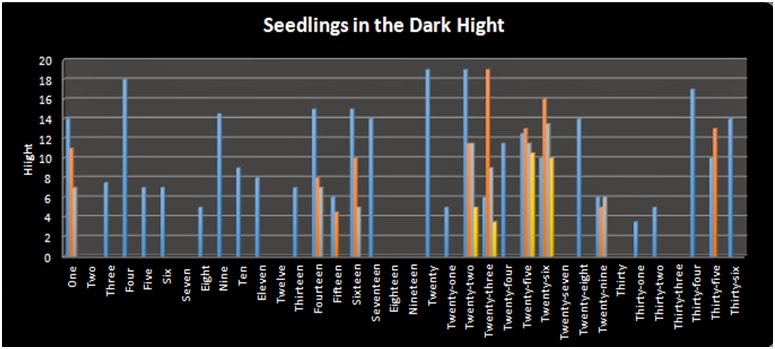Purpose
This Lab is to calculate the
germination and total plant growth in heights of the radish seeds.
This Lab has two treatment one in
the normal light conditions and the other one in total darkness
Question
Can Plants germinate in the dark?
Hypothesis
Seeds do not germinate in the dark
Method
There were 4 groups in charge of
plants in order to have four different samples two in normal light and two in
the darkness. Each group planted four seeds (Tuesday January 21) per cup in 36
cups for every sample; in order to have repetition.
This week in lab is going to be
focus and the germination part. It wills considerate a seed germinated when is
successfully sprouts into the seedling. When all of the data is collected is
possible to calculate the percent of germination the process will be taking the total number of seeds germinated
and dividing that by the total number of seeds planted, and then multiplying it
by 100. Moreover is necessary to measure the distance between the soil and
the tip of the plant in centimeters
The section two
is about calculations of GPP and NPP of the plants by weighing the plants
(mass) in grams and then put those plants in the toaster oven in order to
represent when the plants loss their energy it will take 2 to 5 minutes; after
dry the seedlings those have to be re-weigh.
Here the process is to apply the
Formula NPP+R=GPP where NPP is the total up the dry weight of the light
treatment samples and the R stand for the total up weight of all the dark treatment
samples. The last step of the Lab is about compare the two treatment samples in
growth and differences in appearance.
What was our control for this experiment?
The experiment of germination y
productivity was carried out in the dark with radish seeds at the same time a
control experiment with radish seeds was placed on the sunlight. The same
amount of time, seed, and dirt was selected for the experiment and the control
the purpose was to know the influence of sun light in plants in order to
determinate grow and quality o germination.
69/144 * 100 = 47.9% = 48%
Dark treatment, percent germination
50/144*100=34.7% = 35%
Difference in appearance in the dark treatment and the light treatment
The plants that were exposed to the light treatment have a light
green looking while the plants in the dark treatment looked like
fall-yellowish. Both plants germinated but the one in the light has a better
look and a stand up position having a signal of been alive.
If there was growth in the dark treatment plants, explain
why that growth may have taken place.
The plants in the dark treatment grew because seeds do not
need to photosynthesis to germinate. The embryo inside the seed use the energy
stored to germinate and when leaves are up the chloroplasts in it needs the
sunlight to do photosynthesis and continue to grow.
The Director of the studies, Tilman Lamparter, Karlsruhe
Institute of Technology (KIT).Says "The plants developed in the dark as if
they were in light," “The seeds and seedlings of thale cress were fed with
a synthetic substance named 15Ea-phycocyanobilin. In the plant cell, this
substance replaces the natural, photoactive component of the photoreceptor, the
"phytochromobilin". Incorporation of 15Ea-PCBactivates the
photoreceptor and the plant is made believe it is exposed to light. In spite of
the darkness, they grow as they were in the light”.
- Weight before dry 8.9g
- Weight after dry 1.9 g
- Loss 7g NPP+R=GPP
- Duration 5min 1.9+50%= 3.8
- Temperature 400F
Looking for Respiration
Data__________
Loss weight: 7g. 8.9g-----------100
Weight before dry: 8.9g. 7g-------------X
100% X= 7
Light Treatment
Weight before dry 11.4g
Weight after fry 2.0g
Loss 9.4g NPP+R=GPP
Duration 7min 2 + 50% = 4
Temperature 400F
Looking for Respiration
Data__________
Loss weight: 9.4g. 11.4g-----------100
Weight before dry: 11.4g. 9.4g-------------X
100% X= 9.4
X= 82.45% Respiration
Result.
Base on all of the data in necessary to conclude that those plants didn't need the light in order to grow, but the grow rate was less than the ones that were exposed to light.
 |
| Plants that were in the dark |





